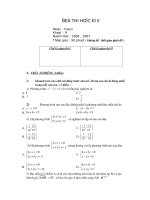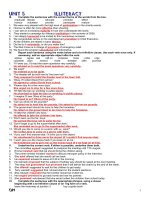- Trang chủ >>
- Mầm non - Tiểu học >>
- Lớp 5
5 3 3 whats new with dinosaur fossils (life science) TG
Bạn đang xem bản rút gọn của tài liệu. Xem và tải ngay bản đầy đủ của tài liệu tại đây (120.76 KB, 4 trang )
What’s New with
Dinosaur Fossils?
SUMMARY
This book explores the most current
findings about dinosaurs and how opinions of
dinosaurs have changed over time.
LESSON VOCABULARY
avid
collaborator
contention
herbivorous
theropods
vertebrae
carnivorous
consensus
descendants
olfactory bulbs
trackways
INTRODUCE THE BOOK
INTRODUCE THE TITLE AND AUTHOR
Discuss with
students the title and the author of What’s
New with Dinosaur Fossils? Have students tell
what the photo on the cover shows. What
do students think they’ll learn about the study
of dinosaurs? Do students think this book will
be fiction or nonfiction? Why?
BUILD BACKGROUND
Discuss students’
knowledge of dinosaurs and dinosaur fossils.
Ask students if they think new discoveries
about dinosaurs have occurred in recent times
and how that might affect how scientists now
think of dinosaurs.
PREVIEW/USE TEXT FEATURES As students
preview the book, draw their attention to the
map on page 15 and discuss what it shows.
Then point out that the captions and the
illustrations in this book contain detailed
information that will help students better
understand the subject.
5.3.3
FACT AND OPINION
PREDICT
READ THE BOOK
SET PURPOSE
Have students set purposes for
reading What’s New with Dinosaur Fossils?
Students’ own interest in dinosaurs and
fossils should guide this interest. To help
prompt students’ purposes, let them know
that many significant discoveries have been
made in recent years, changing the way
scientists think about dinosaurs.
STRATEGY SUPPORT: PREDICT
Remind students
that it is important to be prepared to revise
their predictions. As they read, have them
write down their new predictions. Afterwards,
have students compare predictions and how
they changed as they got more information on
the subject.
COMPREHENSION QUESTIONS
PAGE 4
Reread the first sentence. Is it a
statement of fact or of opinion? (fact)
PAGE 12
What part of the text does this
illustration help support? (The small fossil,
Sinosauropteryx, showed featherlike markings.)
PAGES 16–17
How do the heading and pictures
help you predict what this section will be
about? Would the prediction be harder if the
heading was just Fossils? Why? (Answers will
vary.)
PAGE 18
What can you conclude about
computer technology and paleontology?
(Possible response: Computers are able to
help scientists figure out important information
about dinosaurs.)
PAGE 21
Reread the last sentence. Is it a
statement of fact or opinion? (opinion)
60
What’s New with Dinosaur Fossils?
16924_LRD_TG_060-061 60
6/16/06 12:15:59 PM
REVISIT THE BOOK
READER RESPONSE
1. Possible Response: Facts: Asteroids are
small star-like objects between Mars and
Jupiter. Scientists still have no direct
evidence proving that an asteroid caused
the extinction of the dinosaurs. Opinion: The
story of these amazing animals continues
to fascinate all who read and learn about
them!
2. Responses will vary.
3. carnivore: animal that eats meat; herbivore:
animal that eats plants
4. Possible response: the photograph of the
fossil of Sinosauropteryx on page 12, which
shows what might be feathers
EXTEND UNDERSTANDING
What’s New with
Dinosaur Fossils? provides many illustrations,
a graph, and a map to help students better
understand the information. Ask students
to think about how they used the graphic
sources to understand the written information.
Ask them to discuss what information they
would not really have been able to understand
or visualize without the presence of the
graphic sources.
RESPONSE OPTIONS
WRITING Have students use the information in
this book to write a poem about dinosaurs.
Then have them create illustrations to go
along with their poems.
SCIENCE CONNECTION
Invite students to read fantasy
fiction or to watch a fictional film
about dinosaurs. Then have them
choose one of the dinosaurs from the book or
movie to research. Afterwards, have students
compare what their research showed with how
the book or movie portrayed the dinosaur.
Skill Work
TEACH/REVIEW VOCABULARY
Have students locate the vocabulary words
in the book and discuss which of them can
be satisfactorily defined from context clues.
(Avid, consensus, and contention have the
weakest clues.)
TARGET SKILL AND STRATEGY
FACT AND OPINION Remind students that
a statement of fact can be proved true or
false. A statement of opinion is someone’s
judgment, belief, or way of thinking. Words
like believe, theory, indicate, may have been,
and speculate are clues that the information
is an opinion and not yet proven. (Although
it may be a fact that a scientist speculated.)
Other clues are subjective adjectives such
as fantastic, great, wonderful, etc. Tell
students to look for these clues as they
read.
PREDICT Remind students that to
predict means to tell what you think might
happen next in a selection. Have students
notice the headings in the selection. How
is punctuation a clue to fact and opinion?
(Some headings end in a question mark, a
good indication that the section contains
opinion.)
ADDITIONAL SKILL INSTRUCTION
DRAW CONCLUSIONS Remind students that
drawing a conclusion means making sensible
decisions or forming reasonable opinions
after thinking about the facts and details.
Tell students they should be aware of
conclusions that the scientists in the book
make. Have students reread pages 6–7.
Ask: What information did Owen use to
conclude that extinct reptiles differ from
modern reptiles in the way their legs grew
from their body? (He studied fossils and
noted the ways that the legs grew from the
body.) Ask: What kind of conclusions can
you make about early paleontologists? What
information are you using to draw those
conclusions?
What’s New with Dinosaur Fossils?
16924_LRD_TG_060-061 61
61
1/18/06 10:52:07 AM
Dinosaur Fossils?
Name
Fact and Opinion
• A statement of fact is one that can be proved true or false.
• A statement of opinion is a statement of someone’s judgment, belief, or way of thinking.
Directions In front of each sentence below, write whether it is a statement of fact or a
statement of opinion.
1.
Tyrannosaurus rex was a fearsome killer that probably sprinted
for short distances to catch its prey.
2.
Scavengers are animals that eat dead animals.
3.
Through their analysis of fossils, paleontologists have identified
slightly over three hundred species of dinosaurs.
4.
One of the most fascinating (and controversial) theories
regarding Seismosaurus is that it swung its tail fast enough to
break the sound barrier.
5.
Cold-blooded animals cannot control their own body temperature.
6.
Dinosaur fossils have been found in many places around the
world, including northern climates.
7.
Although dinosaurs are extinct today, the story of these amazing
animals continues to fascinate all who read and learn about them!
Directions Look through What’s New with Dinosaur Fossils? Find one sentence that is a
statement of fact and another that is a statement of opinion. Write them below.
9. Statement of Opinion:
© Pearson Education 5
8. Statement of Fact:
62
16924_LRD_TG_062_063 2
1/4/06 9:42:59 AM
Dinosaur Fossils?
Name
Vocabulary
Directions Use the vocabulary words to answer the questions below. Each word can
only be used once.
Check the Words You Know
© Pearson Education 5
avid
contention
theropods
carnivorous
descendants
trackways
collaborator
herbivorous
vertebrae
consensus
olfactory bulbs
1.
What kind of animal eats only plants?
2.
Which word refers to certain kinds of footprints?
3.
What kind of person would you choose to work
with you on a scientific project?
4.
What is your backbone made up of?
5.
Which word names certain meat-eating dinosaurs
with sharp claws and sharp teeth that may be the
ancestors of birds?
6.
Which word has to do with the sense of smell?
7.
Which word would you use for someone who is
extremely enthusiastic?
8.
What are grandchildren and
great-grandchildren?
9.
Which word describes lions, tigers, and other
meat-eating animals?
10–11.
Which two words mean opposite things?
63
16924_LRD_TG_062_063 3
1/4/06 9:43:00 AM









